Long before the hand-held calculators, there was the millionaire calculator machine—a large, clunky, and expensive mechanical machine that performed direct multiplications with only a single turn of a crank.
Created in 1893 by Swiss engineer Otto Steiger and patented and marketed by Zurich’s Hans Egli company in 1895, the Millionaire Calculator Machine was the first commercially successful mechanical calculator that could perform a direct multiplication.

5 Facts about The Millionaire Calculator Machine
- The Millionaire Machine used a mechanical representation of the multiplication table to form partial products, in the same way that a human “calculator” uses a multiplication table committed to memory.
- Steiger’s machine is to be regarded as a proper multiplication machine in that it solves problems of multiplication directly based on the multiplication table. In contrast, other types of calculating machines are only adding machines and, as such, carry out multiplication by a continued series of additions.
- Although excelling in multiplication and division calculations, the Millionaire’s slider setting mechanism was too slow to be useful in adding long columns of figures.
- The production of the Millionaire lasted between 1893 and 1935.
- In its lifetime, a total of about five thousand machines were manufactured and widely used in technical computations.
The Millionaire Calculator Machine: History
In 1892 the brilliant Swiss engineer Otto Steiger from St. Gallen (1858-1923), who lived in Munich, received his first patent for a calculating machine of direct multiplication type (German patent DE 72870). In the following years, the machine was patented in Switzerland, Great Britain, France, the USA, and Canada.
The machine of Otto Steiger is the fourth designed (after the machines of Barbour, Verea, and Bollée), but the first commercially-successful direct multiplication calculating machine, which was in production until 1935 and despite his extremely high price (e.g., in the USA at the beginning of 20-th century machine was sold from $475 up to $1100, at the same time this was the price of a normal car) had commercial success.

In his German patent of 1892, Steiger describes a machine that uses a mechanical representation of the multiplication table to form partial products, in the same way that a human “calculator” uses a multiplication table committed to memory. The partial products are then transferred via a “transmitting mechanism” to a “combining and registering mechanism” for a display to the operator.
The main advantage of Steiger’s calculating machine (and of all other direct multiplication machines), as against all other types of calculating machines, is the astounding speed with which it operates, especially while doing multiplication and division. Each place of the multiplier or quotient requires only a single turn of the crank, during which the necessary displacement of the result occurs automatically.
For example, a trained operator could multiply two 8-digital numbers in about 7 seconds, incredible speed for this time. Steiger’s machine could not be surpassed for rapid and reliable multiplication until the fully-automatic rotary calculators became available in the mid to late 1930s.
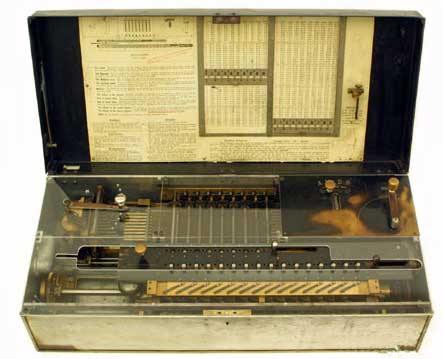
The Millionaire Calculator Machine: How it worked
The Millionaire was primarily a multiplying machine, not an adding machine, and is best described and understood from this perspective.
When we multiply (say) 7 by 6, the result comprises four tens and two units. The multiplication table that we have stored in our memory retrieves the answer as the single number 42. The Millionaire also contains a multiplication table but differs in that it processes the tens and units for each digit separately. These “partial products” are combined in an accumulator register to display a single result.
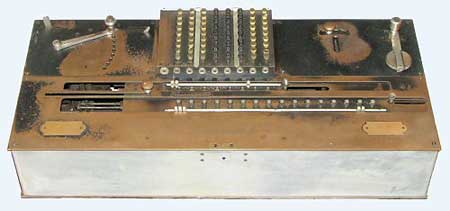
When the Millionaire multiplies 7 by 6, its controlling mechanism refers to the internal multiplication table and returns the partial product 4 (tens). This is added to the register, which then moves one place to the left. The multiplication table then returns 2 (units), which is added to the register (now to the right of the tens) to display the answer 42. The machine requires only one crank turn for each digit of the multiplier but makes two partial-product cycles for each turn—one for the tens, then one for the units.
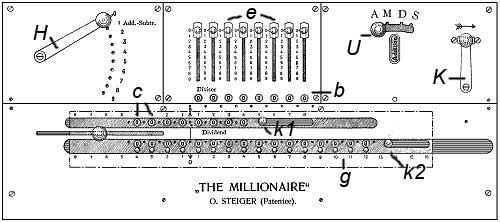
How to perform arithmetic operations:
Multiplication:
The machine is first cleared, the carriage is returned to the right-hand side, and the Regulator is set to (for multiplication). The first factor (the multiplicand) is set on the sliders or keyboard. The multiplier lever is set to the first (most significant) digit of the second factor, and the crank is given one full turn clockwise. The set-and-turn procedure is repeated for the remaining digits. At the end of the process, all three components are visible for verification—the multiplicand in the setting mechanism, the multiplier in the counter register, and the result in the accumulator.
Addition:
To perform an addition on a multiplying machine, the carriage is held stationary, while the entry is multiplied by 1. The partial product is the same as the original entry, which is added to the accumulator.
The operator has to clear the machine, return the carriage to the right-hand side, set the Regulator to A, and set the multiplier to 1. Numbers entered on the setting mechanism are added to the accumulator by turning the crank. The carriage does not move, and the counter mechanism does not operate.
Internally, setting the Regulator to disconnects the carriage shift driving dog so that the carriage will remain stationary. With the multiplier set to 1, there will be no movement of the racks on the tens cycle. On the units cycle, the value in the setting mechanism will be multiplied by 1 and added to the accumulator. The motor-driven machine has a lever (at the rear of the multiplier panel) that locks the multiplier lever at 1 and engages the automatic keyboard clearing mechanism at the end of each cycle.
Subtraction:
Subtraction is the same as addition, except that the differentials drive the register in the opposite direction. If the initial value for subtraction is not already present in the accumulator (as a result of a previous calculation), it can be entered manually using the twirler knobs.
Division:
Division is performed by the usual method of repeated subtraction, but with the advantage that multiple subtractions can be performed in a single operation. The carriage is first cleared and returned to the right, and the Regulator is set to. The dividend is set in the accumulator using the twirlers, starting one place from the left-hand end (to allow for the automatic carriage shift). The divisor is set at the left-hand side of the sliders or keyboard.
The operator estimates the number of times the divisor can be subtracted from the dividend by comparing the initial digits of each, then sets the multiplier lever to the estimate and turns the crank. At the completion of the cycle, the number set on the multiplier lever appears in the counter as the first digit of the quotient, the product of the quotient digit, and the divisor has been subtracted from the accumulator and the carriage has been moved one place to the left. The process is repeated until sufficient digits have been obtained.
The efficiency of division on the Millionaire depends on the operator’s skill in estimating the quotient digits, as much time can be lost in correcting a poor estimate. If the estimate is too high, an overdraft will occur, and the bell will ring. To cancel the excess subtraction, the operator has to change the Regulator to Addition, set the multiplier to 1, turn the crank until the overdraft is cleared, then change the Regulator back to Division and continue.

If the estimate is too low, there is no warning bell. In preparing the next estimate, the operator must be alert to observe that the divisor is greater than the dividend and then follow a similar process to perform an extra subtraction.
As an aid to less skilled operators, a chart of 1-to-9 times 1-to-99 is fastened inside the machine’s lid, with a pair of sliding metal cursors and a set of instructions for a purely mechanical method of estimation. It is still possible for occasional errors to be made due to differences in the third place.
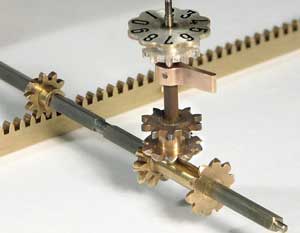

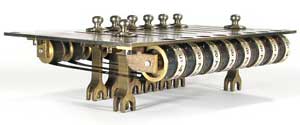
The Millionaire Calculator Machine: Historical Significance
The Millionaire calculator machine was an improvement of the León Bollée machine and was capable of performing multiplication directly, without obtaining the result by the formula of repetition. Although the Millionaire was developed for business calculations, scientists also found it very useful, and government agencies became the prime customers.
Later models had a keyboard, which made it easy for users to enter characters and perform tasks quickly. Even though its production ended in 1935, the idea has been a useful stepping stone to developing today’s calculators.